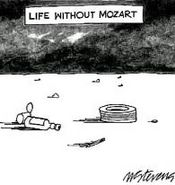Jefferson's cheese
My daughter Melina pointed out, when I wrote my account of the Giant Cheese of Perth, Canada, that there had been an exalted predecessor: the Mammoth Cheese given to Thomas Jefferson on New Year's Day, 1802.
| Actually there may have been TWO predecessors - Jeffrey Pasley opines there was "a similar large dairy product made in Cheshire, England, to celebrate George III’s recovery" from porphyria. I'm not sure I believe in this proto-cheese - jeez, they didn't even MENTION it in The Madness of King George - which was a really great movie and in which we see George blogging on July 4, 1776: "Nothing of importance happened today." |
The cheese had been en route for more than a month by the time a Baptist preacher, John Leland, finally got it to the White House from Cheshire Massachusetts. It wore a sign saying: "The Greatest Cheese in America for the Greatest Man in America!"
The previous year, Leland had preached from his pulpit the idea of making a giant cheese to celebrate Jefferson's election. The congregation was enthusiastic and plans were made.
On July 20 1801 the "Ladies of Cheshire," dressed to the nines, assembled at a big cheese bee with pails of curds from "900 cows at one milking." These had all, by the way, been Republican cows - the milk of Federalist cows was "scrupulously excluded." During a day of hymn singing the curds were packed into a giant cider press.
The finished cheese was ungainly: more than four feet in diameter, thirteen feet in circumference, weighing 1,235 pounds, it would have sunk into muddy spring roads. Therefore it was decided to make delivery in winter, by sled and boat.
Leland and a member of his congregation travelled with the cheese for a month, causing a sensation wherever they stopped. Leland, an enthusiastic evangelist, preached along the way to large crowds, which he framed as "large congregations". He was of the old school: "Such a farrago," it was reported, "bawled with ... horrid tone, frightful grimaces, and extravagant gestures ... was never heard by any decent auditory before."
"By the time it reached Baltimore, one wag reported, the ripening cheese, now nearly six months removed from the cows, was strong enough to walk the remaining distance to Washington." (Daniel Dreisbach)
Jefferson, "whose typical manner on public occasions was low-key to the point of sedation," appeared "highly diverted" by the arrival of the cheese. He stood in the doorway of the White House, arms spread wide, to receive the emissaries and their cargo.
| Edward S. Ellis wrote: "Mr. Jefferson was not in the habit 'of deadheading at hotels,' nor of receiving presents, however inconsiderable in value, which would place him under any obligation to the donor. His financial diary contains the following minute regarding the cheese: 1802. Gave Rev'd Mr. Leland, bearer of the cheese of 1235 Ibs weight, 200 D." (About sixteen cents a pound) |
The Federalists blogged furiously about the cheese. "If we were not so convinced of the stupidity of the Jacobin encomium-mongers," snarked one, "we should imagine the whole introduction to the cheese vat to be conceived in a vein of irony." It was they who coined the nickname "Mammoth Cheese." They intended to mock simultaneously the cheese and Jefferson's interest in science: it was with government assistance that woolly mammoth (mastodon) bones had just then been dug up, a silly enterprise in their opinion.
However, people actually loved the cheese, the mastodon, the word "mammoth," and the very concept of bigness.
| Jeff Pasley): Giant foodstuffs and fossils seemed to speak some democratic, patriotic idiom that the Federalists did not understand. ... A copycat baker in Philadelphia advertised "Mammoth Bread" for sale; a "Mammoth Eater" in Washington downed 42 eggs in ten minutes; and two admiring Philadelphia butchers sent what Jefferson himself referred to as a "Mammoth veal," a hindquarter of the largest calf "we remember ever to have seen in this part of the country," 436 pounds at only 115 days old. By the time the veal got to Jefferson, however, its age was such that he declined to eat it. |
More than two years later a "pungent remnant" of the cheese was still being prominently displayed at the White House and fragments were being served on ceremonial occasions, although "very far from good."
The very last decayed and maggotty chunks were eventually dumped into the Potomac.
| In 1829, two of the 1801 curd suppliers, Israel and Molly Cole, sent another new Democratic president another congratulatory cheese, along with a cover letter inquiring about the new administration's naval policy. At 100 pounds, however, Andrew Jackson's cheese was only relatively mammoth. (Pasley.) |
Later my daughter Melina added:
My professor Joanne Freedman likes to use this story to show how Americans seemed to divide their presidents into two categories: Those who they thought would appreciate a spontaneous gift of a Mammoth Wheel of Cheese, and presidents who they did not think would appreciate it.
Jefferson, Jackson: would get cheese
John Adamses, snarky New Yorker Martin van Buren: would not get cheese.
Technorati Tags: History, Cheese, Jefferson



 A few of my daughter
Melina's great posts:
A few of my daughter
Melina's great posts:








2 Comments:
Knowing Ole Hickory, he probably used the cheese as a target when he practiced with his dueling pistols.. ;)
Melinama:
The Queen of Cheese was actually made in ingersoll, Ontario.
Keep up the lovely blog.
Alastair Sweeny
Post a Comment
<< Home